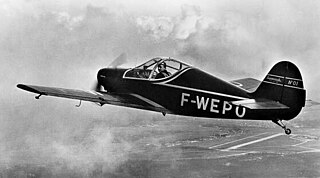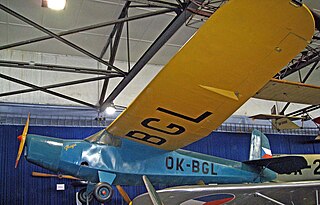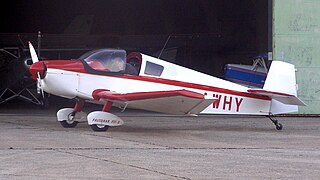
The Luton L.A.5 Major was a 1930s British two-seat high-wing cabin monoplane. Following World War II, plans were made available to suit construction as a homebuilt aircraft.

The CAB GY-30 Supercab was a two-seat light aircraft built in France in 1954, as a further development of the CAB Minicab. The design was performed by Yves Gardan, a onetime employee of French aeronautical company SIPA. Changes incorporated in the Supercab included a more powerful engine, greater wingspan, manually retractable undercarriage, and slotted flaps that replaced the split flaps of the Minicab.
Constructions Aéronautiques du Béarn (CAB) was a French aircraft manufacturer established by Max Laporte and Yves Gardan in Pau, Béarn in 1948. Its main product was the Minicab, a two-seat low-wing monoplane light aircraft of Gardan's design constructed in wood with a fabric covering, and equipped with a fixed tailwheel undercarriage, while the similar Supercab had a retractable undercarriage and detail refinements. The company ceased business in the mid-1950s.

The Praga E.114 was a single-engine sport airplane, designed and manufactured by the Czechoslovakian company ČKD-Praga. Due to its light weight it was also called Air Baby.
The Falconar Teal was a two-seat homebuilt, amphibious airplane designed by Chris Falconar of Edmonton, Alberta, Canada. From the 1970s to the 1990s plans were sold by Falconar Aviation of Edmonton. A handful were built by amateur aircraft constructors in Canada and the United States. Most were powered by certified Lycoming or Continental engines.
The Falconar AMF-S14 Maranda is a two-seat, light aircraft first flown in Canada in 1961 and originally marketed for amateur construction by Falconar Avia.
The Fletcher FBT-2 was a military trainer aircraft built in the United States in the early 1940s. Although it was never entered production as a trainer, it was ordered in small numbers as a target drone but when that was cancelled played a small part in the development of guided bombs.

The Malmö MFI-10 Vipan was a four-seat light utility monoplane designed and built in Sweden by Malmö Flygindustri. Only three aircraft were built and the type did not enter quantity production.

The GY-80 Horizon is a French four-seat touring monoplane of the 1960s designed by Yves Gardan and built under licence, first by Sud Aviation, and later by that company's SOCATA subsidiary.

The SIPA S.90 was a French-built two-seat light touring and training aircraft of the 1940s and 1950s.

The SIPA S.1000 Coccinelle was a French-built light civil utility aircraft of the 1950s.

The SNCASO S.O.7050, S.O.7055, S.O.7056 and S.O.7060 Deauville were single-engine light French civil utility aircraft of the 1940s. Only two airframes were built but were modified with different undercarriages, engines and seating.

The RAE Scarab was a light single-engined single-seat parasol winged modification of the de Havilland Humming Bird, flying in the United Kingdom in 1932. Only one was built.

The Carden-Baynes Bee was a 1930s British two-seat aircraft, with twin engines in pusher configuration buried in the wings. The wings rotated for storage. Financial problems limited the Bee to a single flight.
The SITAR GY-100 Bagheera was a light aircraft designed and built in France in the late 1960s. Designed by Yves Gardan, it was a low-wing, cantilever monoplane of conventional layout with fixed, tricycle undercarriage. The fully enclosed cabin had seating for up to four people in 2+2 configuration. Construction was of metal throughout.
The SITAR GY-90 Mowgli was a light aircraft designed in France in the late 1960s and marketed for homebuilding. Designer Yves Gardan intended it to be a smaller and simpler version of his Bagheera, a conventional low-wing, cantilever monoplane with fixed tricycle undercarriage and a fully enclosed cabin. However, although the Bagheera had seating for up to four people in 2+2 configuration, the Mowgli had no rear seat and could seat only two people, with space behind the seats for luggage. Like the Bagheera, construction was of metal throughout. The Mowgli was designed to use either a 67-kW (90-hp) or 75-kW (100-hp) Continental flat-4 engine.
The SITAR GY-110 Sher Khan was a light aircraft designed in France in the late 1960s as a larger and more powerful version of designer Yves Gardan's Bagheera. Like the Bagheera, it was to be a conventional low-wing, cantilever monoplane with a fully enclosed cabin. However, although the Bagheera had seating for up to four people in 2+2 configuration, the Sher Khan was to have a stretched fuselage with full seating for four people. The wingspan was also to be enlarged, and unlike the Bagheera, whose tricycle undercarriage was fixed, the Sher Khan's was to be retractable.

The MacFam Cavalier is a homebuilt aircraft designed by Stan McLeod, developed through a progressing series of models, all using all-wooden construction. The model range includes the SA102, SA102.5, SA103, SA104 and the SA105.
The Gardan GY-120 was a single engine, parasol wing ultralight seating two in tandem, designed and built in France in the 1980s. It did not go into production.

The Falconar F11 Sporty is a Canadian amateur-built aircraft, that was designed by Chris Falconar and produced by Falconar Avia. Falconar supplied it as a kit or as plans for amateur construction. Today both the F11A and E models are available as plans from Manna Aviation.













